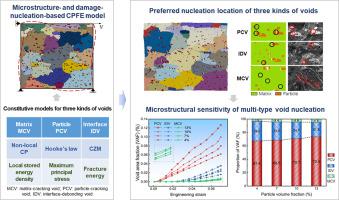International Journal of Plasticity ( IF 9.8 ) Pub Date : 2023-04-07 , DOI: 10.1016/j.ijplas.2023.103609 P.F. Gao , M.Y. Fei , M. Zhan , M.W. Fu

|
During deformation of aluminum (Al) alloys, there are three kinds of voids being formed by distinct mechanisms, i.e., matrix-cracking voids (MCVs), particle-cracking voids (PCVs), and interface-debonding voids (IDVs), due to mesoscale heterogeneous deformation. The three kinds of void nucleation have different effects on the subsequent void growth, void coalescence, and ductile fracture of Al alloys. To determine the complex nucleation behavior of the three kinds of voids under mesoscale heterogeneous deformation, a microstructure- and damage-nucleation-based crystal plasticity finite element (MDN CPFE) model considering different nucleation mechanisms was established. To realize the MDN-CPFE modeling, the deformation and void nucleation of the matrix, particle, and their interface in Al alloys were described by a non-local dislocation density CP constitutive model and a local stored energy density criterion, an elastic constitutive model and a maximum principal stress criterion, and a cohesive zone model and fracture energy criterion, respectively. The developed MDN-CPFE model was validated by the nucleation locations and quantitative variations of the three kinds of voids in an in-situ tensile test. Using the developed model, the nucleation characteristics of the three kinds of voids during the small deformation of Al alloys were analyzed. It is found that PCVs are likely to nucleate within particles that are located at the deformation bands and with greater shape irregularity; IDVs are prone to nucleate at the interfaces around smaller particles in the deformation bands; MCVs tend to nucleate within grains with a higher Schmid factor and aspect ratio. The void area fractions (VAFs) of the three kinds of voids all evolve with an incubation stage and then followed by an exponentially increasing stage during deformation. The duration of the incubation stage for the three kinds of voids, designated by the nucleation strain, presents the following sequence: PCV < IDV < MCV; while, their VAFs and quantities present the opposite sequence. Additionally, the effects of the particle volume fraction and grain size on the nucleation strain, total VAF, and proportion of VAFs of the three kinds of voids were unraveled.
CPFE) model considering different nucleation mechanisms was established. To realize the MDN-CPFE modeling, the deformation and void nucleation of the matrix, particle, and their interface in Al alloys were described by a non-local dislocation density CP constitutive model and a local stored energy density criterion, an elastic constitutive model and a maximum principal stress criterion, and a cohesive zone model and fracture energy criterion, respectively. The developed MDN-CPFE model was validated by the nucleation locations and quantitative variations of the three kinds of voids in an in-situ tensile test. Using the developed model, the nucleation characteristics of the three kinds of voids during the small deformation of Al alloys were analyzed. It is found that PCVs are likely to nucleate within particles that are located at the deformation bands and with greater shape irregularity; IDVs are prone to nucleate at the interfaces around smaller particles in the deformation bands; MCVs tend to nucleate within grains with a higher Schmid factor and aspect ratio. The void area fractions (VAFs) of the three kinds of voids all evolve with an incubation stage and then followed by an exponentially increasing stage during deformation. The duration of the incubation stage for the three kinds of voids, designated by the nucleation strain, presents the following sequence: PCV < IDV < MCV; while, their VAFs and quantities present the opposite sequence. Additionally, the effects of the particle volume fraction and grain size on the nucleation strain, total VAF, and proportion of VAFs of the three kinds of voids were unraveled.
中文翻译:

铝合金塑性变形过程中多类型空洞形核的微观结构和损伤形核晶体塑性有限元建模
在铝 (Al) 合金的变形过程中,通过不同的机制形成三种空隙,即基体开裂空隙 (MCV)、颗粒开裂空隙 (PCV) 和界面剥离空隙 (IDV),这是由于中尺度异质变形。三种空洞形核对铝合金后续的空洞长大、空洞聚结和韧性断裂有不同的影响。为了确定三种空隙在细观非均匀变形下的复杂形核行为,基于微观结构和损伤形核的晶体塑性有限元(MDN CPFE)模型建立了考虑不同成核机制的模型。为了实现 MDN-CPFE 建模,采用非局部位错密度 CP 本构模型和局部储能密度准则、弹性本构模型和分别是最大主应力准则、粘性区模型和断裂能准则。开发的 MDN-CPFE 模型通过原位拉伸试验中三种空隙的成核位置和数量变化进行了验证。利用所建立的模型,分析了铝合金小变形过程中三种空洞的形核特征。发现PCVs很可能在位于变形带处且形状不规则性较大的颗粒内成核;IDV 易于在变形带中较小颗粒周围的界面处成核;MCV 倾向于在具有更高 Schmid 因子和纵横比的晶粒内成核。三种空隙的空隙面积分数 (VAF) 都在变形过程中经历孵化阶段和指数增长阶段。由成核应变指定的三种空隙的孵育阶段的持续时间呈现以下顺序:PCV < IDV < MCV; 而它们的 VAF 和数量则呈现相反的顺序。此外,颗粒体积分数和晶粒尺寸对形核应变、总 VAF、
CPFE)模型建立了考虑不同成核机制的模型。为了实现 MDN-CPFE 建模,采用非局部位错密度 CP 本构模型和局部储能密度准则、弹性本构模型和分别是最大主应力准则、粘性区模型和断裂能准则。开发的 MDN-CPFE 模型通过原位拉伸试验中三种空隙的成核位置和数量变化进行了验证。利用所建立的模型,分析了铝合金小变形过程中三种空洞的形核特征。发现PCVs很可能在位于变形带处且形状不规则性较大的颗粒内成核;IDV 易于在变形带中较小颗粒周围的界面处成核;MCV 倾向于在具有更高 Schmid 因子和纵横比的晶粒内成核。三种空隙的空隙面积分数 (VAF) 都在变形过程中经历孵化阶段和指数增长阶段。由成核应变指定的三种空隙的孵育阶段的持续时间呈现以下顺序:PCV < IDV < MCV; 而它们的 VAF 和数量则呈现相反的顺序。此外,颗粒体积分数和晶粒尺寸对形核应变、总 VAF、


























 京公网安备 11010802027423号
京公网安备 11010802027423号